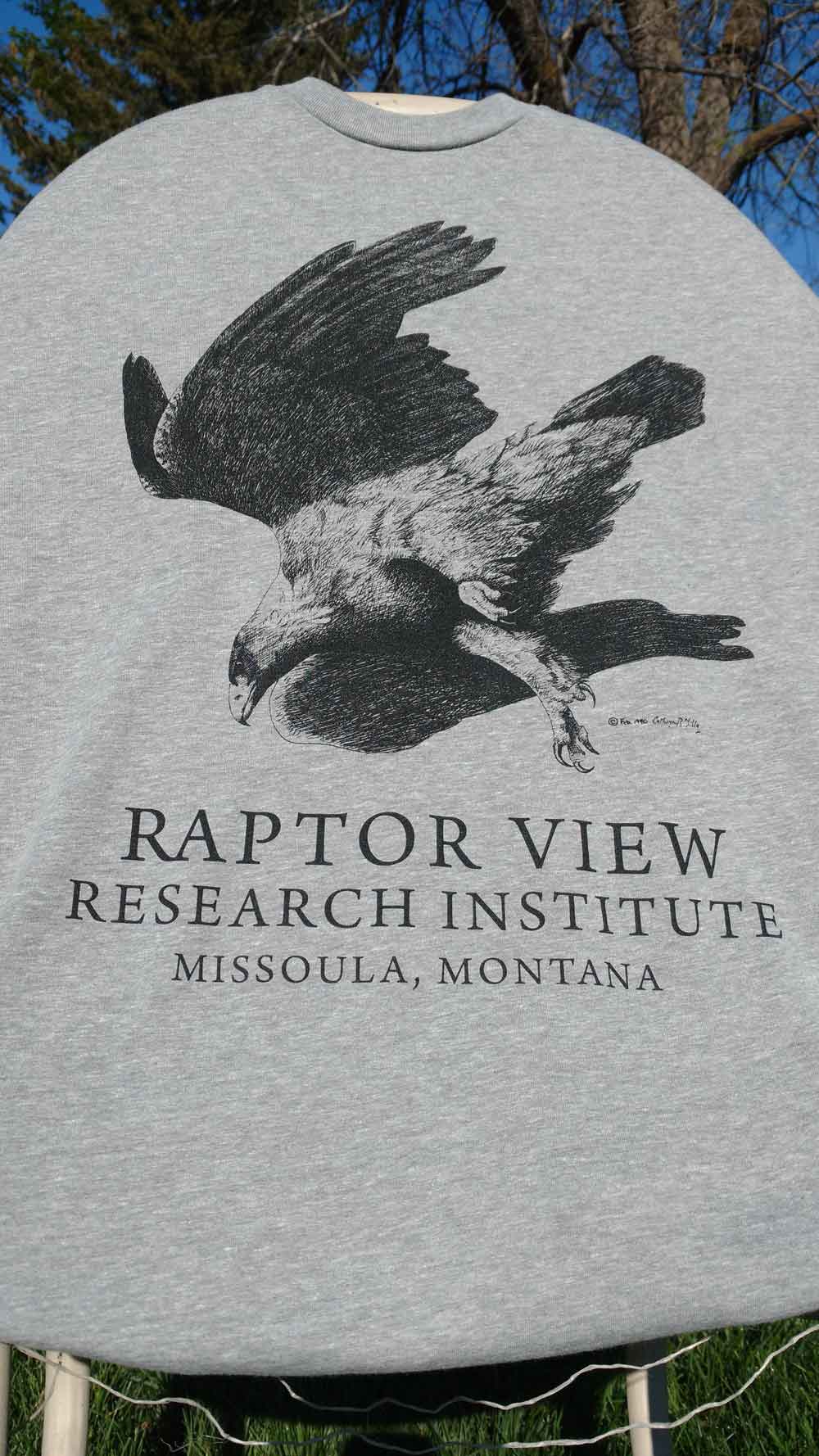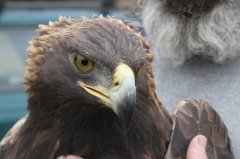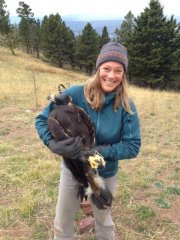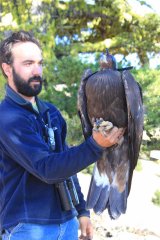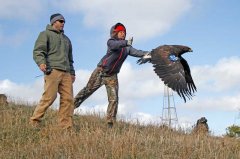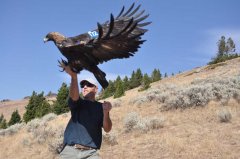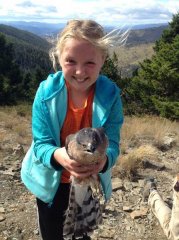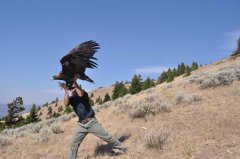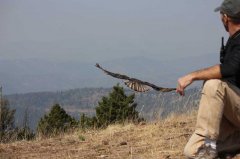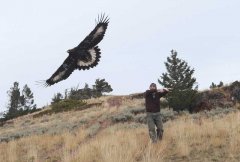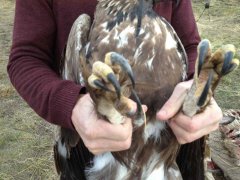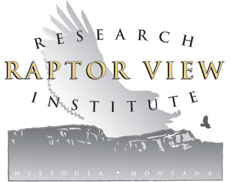
WELCOME TO RAPTOR VIEW RESEARCH INSTITUTE
Raptor View Research Institute, Inc. is a non-profit research and education organization established in 2004 and based in Missoula, Montana. The mission of RVRI is to provide knowledge of raptors (birds of prey) and the ecosystems that support them to the public and scientific community, through research conservation and education. Learn more >>
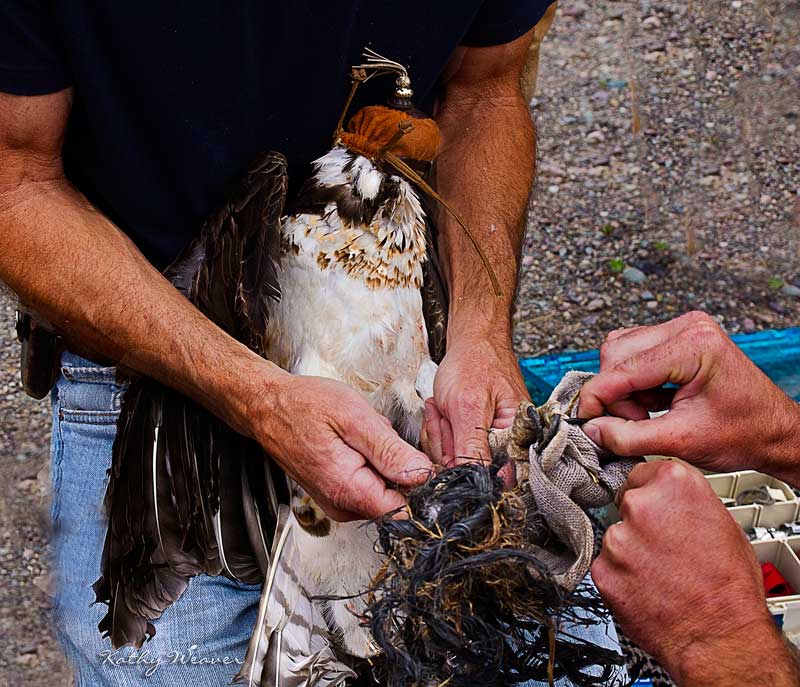 Ospreys have the bad habit of collecting baling twine to adorn their nests. Unfortunately, baling twine is a serious threat to Osprey, as they often get tangled in this very strong polypropylene rope. We have found baling twine in nearly every nest located in our study area. An Osprey nest that blew down in Missoula contained more than a quarter of a mile of baling twine!
Ospreys have the bad habit of collecting baling twine to adorn their nests. Unfortunately, baling twine is a serious threat to Osprey, as they often get tangled in this very strong polypropylene rope. We have found baling twine in nearly every nest located in our study area. An Osprey nest that blew down in Missoula contained more than a quarter of a mile of baling twine!
One of our new research partners, Brooke Tanner, founder of the newly incorporated and developing Wild Skies Raptor Rehabilitation Center received a call about an Osprey that was, “…tangled in baling twine and dangling from a utility pole…” To complicate matters, the nest platform was located above dangerous power lines and the Osprey was hanging and swinging precariously close to those lines. The utility pole is managed by Missoula Electric Cooperative (MEC).
MEC linemen wasted no time in getting there. In just minutes, the crew expertly positioned their bucket truck under the nest. With large salmon dip nets in-hand, we positioned ourselves under the truck ready to catch the struggling bird should it fall. The lineman used a fiberglass pole with a bottle brush wire head to secure the line, and with another pole equipped with a knife, cut the twine. Carefully, the en-tangled bird was lowered it into our net. Success!
Brooke examined the leg and wing and determined the bird was okay. We quickly fitted the adult Osprey with a USGS aluminum leg band and freed it back into the wild. Crews then cut down the re-maining twine.
This is a very preventable problem and one we will keep working on diligently to remedy. For more information or for copies of our Osprey and Baling Twine pamphlets contact This email address is being protected from spambots. You need JavaScript enabled to view it.
Learn more about Osprey and bailing twine in our Osprey Pamphlet (PDF, 380kb)
News article - Mother osprey tangled in Missoula nest freed - Missoulian 6/21/14
Our camera will be back online in April 2015, when the Osprey return to Montana to nest.
Unfortunately, Osprey did not use our nesting platform during the 2011 or 2012 breeding season. This wouldn't be possible if not for the generous donations of time, equipment and expertise from local individuals and businesses including: Dave Taylor Roofing, Missoula Electric Cooperative, Ashcroft Electric, Missoula Vann's, Rob Magana of RT Automotive and last, but by no means least, Ryan Alter and the team at Alter Enterprises for all their technical expertise and dedication to this project.
Thanks! Also, special thanks to our partners in the Osprey research, Dr. Erick Greene and Dr. Heiko Langner of the University of Montana. Heiko has set up two Osprey Cams on local area nests. To take a look at these CLICK HERE!
To date, we have accessed about 40 nests, drawn blood samples (for heavy metal analysis) and banded 330 nestlings. This makes our Osprey
project one of the largest and most comprehensive of its kind. Results are troubling, with many nestlings showing mercury levels 100 times higher than what would be considered toxic in humans.
We are proud to be partnering with several local experts, Uni- versity of Montana researchers Dr. Heiko Langner and Dr. John- ny Moore (Environmental Biogeochemistry Lab) and Dr. Erick Greene (Division of Biological Sciences and Wildlife Biology), to closely examine the causes, locations and possible ef- fects of mining-related and possibly atmospheric contaminants on Ospreys and the ecosystems that support them.
To learn more about this toxicology project, please see our resent publication in the Archives of Environ- mental Contamination and Toxicology. The paper is titled: Mercury and Other Mining-Re- lated Contaminants in Ospreys along the Upper Clark Fork River.
Color Banding
In 2010 we began color banding Osprey (blue with white numbers), as this greatly enhanc- es our chances of identifying individual from a distance. Specifically identifying individuals wearing only a metal USGS band almost always means they must be recaptured or found as mortalities. In total, we have color banded 180 individual Osprey and the encounters are starting to come in. This year a chick banded in 2012 was seen as a healthy adult all the way in Honduras!
Baling Twine
Ospreys have the bad habit of collecting baling twine to adorn their nests. Unfortunately, baling twine is a serious threat to Osprey, as they often get tangled in this durable polypropylene rope. We have found baling twine in nearly every nest located in our study area. For example, one Osprey nest that blew down in Missoula contained more than a quarter of a mile of baling twine!
Every summer we get calls about Osprey tangled in baling twine. We always drop whatever we are doing to see if we can rescue these tangled birds. It is important to get to the Osprey quickly, before it suffers irreparable damage by way of amputation, heat stress, broken bones and so on. Unlike many other human-caused environmental problems facing wildlife, this is a simple one, with an easy fix. We ask landowners and stewards to please clear their fields and property of the deadly twine. By simply picking up the loose strands and properly disposing of the material, we can save untold numbers of Osprey.
Learn more about the Osprey Bailing Twine Project
To help spread the word, Erick and Anne Greene put together an informative pamphlet addressing this is issue.
Learn more about Osprey and bailing twine in our Osprey Pamphlet (PDF, 380kb)
For more information or for copies of this Osprey and Baling Twine pamphlet contact This email address is being protected from spambots. You need JavaScript enabled to view it..
![]()
- Send us an email to rob (at) raptorview.org to sign up for our electronic newsletter, or your address for a hard copy.
- Elaine our sattelite tracked adult female Golden Eagle has reached her summer range! To learn more Click Here.
- Raptor View T-Shirts Available!!
- Check out our Newsletters - Download or Read Online
- Support Raptor View Research Institute - Your contribution is critical to our work!
![]()
- Golden Eagle Satellite Tracking Study
Employs satellite technology to determine appropriate conservation and management strategies.
Read more >> - Swainson's Hawk Nesting Project
Focuses on Swainson's Hawks nesting ecology in the Missoula County area.
Read more >> - Osprey Citizen-Science Project
Gives high school students the opportunity to document and monitor osprey platforms used for nesting in the Missoula area.
Read more >> - Flagship Project
Provides positive youth development for Missoula area school kids.
Read more >> - Golden Eagle Wing Tag Project
Keep an eyeout for our blue wing tagged Golden Eagles, and send us sighting information.
Read more >>
New 2018 Tshirts!
Frontpage Vertical Strip Thumbnails
raptor-view-research-1.jpg
http://66.147.240.156/~raptorvi/images/frontpage-vertical-strip/raptor-view-research-1.jpg
raptor-view-research-3.jpg
http://66.147.240.156/~raptorvi/images/frontpage-vertical-strip/raptor-view-research-3.jpg
raptor-view-research-4.jpg
http://66.147.240.156/~raptorvi/images/frontpage-vertical-strip/raptor-view-research-4.jpg
raptor-view-research-5.jpg
http://66.147.240.156/~raptorvi/images/frontpage-vertical-strip/raptor-view-research-5.jpg
raptor-view-research-6.jpg
http://66.147.240.156/~raptorvi/images/frontpage-vertical-strip/raptor-view-research-6.jpg
raptor-view-research-7.jpg
http://66.147.240.156/~raptorvi/images/frontpage-vertical-strip/raptor-view-research-7.jpg
raptor-view-research-8.jpg
http://66.147.240.156/~raptorvi/images/frontpage-vertical-strip/raptor-view-research-8.jpg
raptor-view-research-9.jpg
http://66.147.240.156/~raptorvi/images/frontpage-vertical-strip/raptor-view-research-9.jpg
raptor-view-research-10.jpg
http://66.147.240.156/~raptorvi/images/frontpage-vertical-strip/raptor-view-research-10.jpg
raptor-view-research-2.jpg
http://66.147.240.156/~raptorvi/images/frontpage-vertical-strip/raptor-view-research-2.jpg













